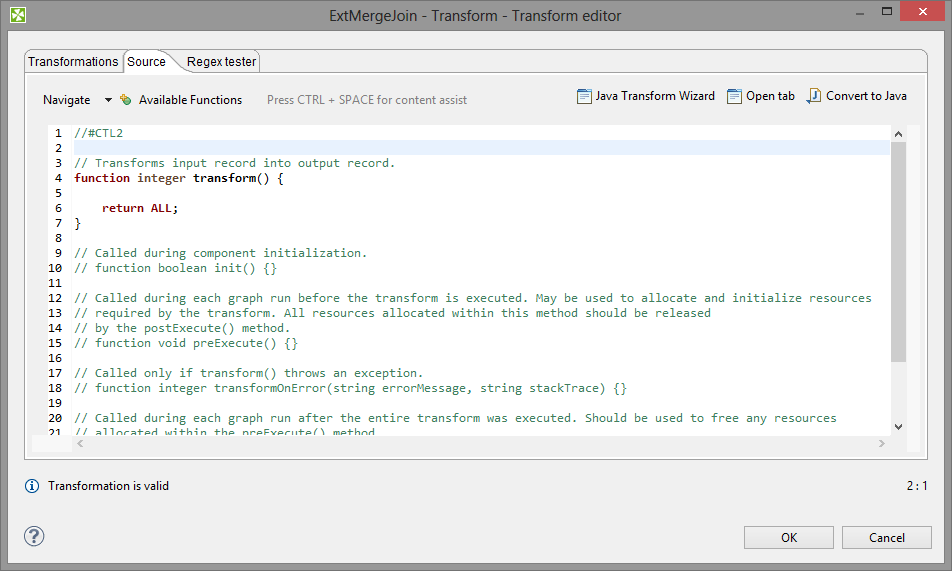CTL Templates for Joiners
This transformation template is used in every Joiner and also in Reformat and DataIntersection.
Here is an example of how the Source tab for defining the transformation in CTL looks.
 |
Figure 56.1. Source Tab of the Transform Editor in Joiners
Table 56.2. Functions in Joiners, DataIntersection and Reformat
| CTL Template Functions | |
|---|---|
| boolean init() | |
| Required | No |
| Description | Initialize the component, setup the environment, global variables |
| Invocation | Called before processing the first record |
| Returns | true | false (in
case of false, the graph fails) |
| integer transform() | |
| Required | yes |
| Input Parameters | none |
| Returns | Integer numbers. See Return Values of Transformations for detailed information. |
| Invocation | Called repeatedly for each set of joined or intersected input records (Joiners and DataIntersection) and for each input record (Reformat). |
| Description | Allows you to map input fields to the output fields
using a script. If any part of the transform() function for some output record
causes fail of the transform() function,
and if user has defined another function (transformOnError()),
processing continues in this transformOnError()
at the place where transform() failed. If transform() fails
and user has not defined any transformOnError(),
the whole graph will fail. The transformOnError() function
gets the information gathered by transform()
that was gotten from previously successfully processed code.
Also error message and stack trace are passed to transformOnError(). |
| Example | function integer transform() {
$out.0.name = $in.0.name;
$out.0.address = $in.0.city + $in.0.street + $in.0.zip;
$out.0.country = toUpper($in.0.country);
return ALL;
} |
| integer transformOnError(string errorMessage, string stackTrace, integer idx) | |
| Required | no |
| Input Parameters | string errorMessage |
string stackTrace | |
| Returns | Integer numbers. See Return Values of Transformations for detailed information. |
| Invocation | Called if transform() throws an exception. |
| Description | It creates output records. If any part of the transform() function for some output record
causes fail of the transform() function,
and if user has defined another function (transformOnError()),
processing continues in this transformOnError()
at the place where transform() failed. If transform() fails
and user has not defined any transformOnError(),
the whole graph will fail. The transformOnError() function
gets the information gathered by transform()
that was gotten from previously successfully processed code.
Also error message and stack trace are passed to transformOnError(). |
| Example | function integer transformOnError(
string errorMessage,
string stackTrace) {
$in.0.name = $in.0.name;
$in.0.address = $in.0.city + $in.0.street + $in.0.zip;
$in.0.country = "country was empty";
printErr(stackTrace);
return ALL;
} |
| string getMessage() | |
| Required | No |
| Description | Prints error message specified and invoked by user |
| Invocation | Called in any time specified by user
(called only when transform() returns value less than or equal to -2). |
| Returns | string |
| void preExecute() | |
| Required | No |
| Input parameters | None |
| Returns | void |
| Description | May be used to allocate and initialize resources required by the transform.
All resources allocated within this function should be released by the postExecute() function. |
| Invocation | Called during each graph run before the transform is executed. |
| void postExecute() | |
| Required | No |
| Input parameters | None |
| Returns | void |
| Description | Should be used to free any resources allocated within the preExecute() function. |
| Invocation | Called during each graph run after the entire transform was executed. |
![[Important]](figures/important.png) | Important |
|---|---|
|
![[Warning]](figures/warning.png) | Warning |
|---|---|
Remember that if you do not hold these rules, NPE will be thrown! |